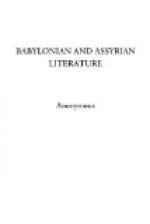6. Below the preceding one.
Either the author of the treaty, or the
hazan of the land of
Zunire.
7. Included between the roost and the back of the dog occurs another sentence which has not been translated.
8. Across the symbolical figures [commencement obscure]:
That he might not watch upon the streets of Bit-Ada.
9. Between the scorpion and the back of the snake.
That he may pay the rent of the land.
10. Over the head of the snake.
That in his abode, there may not be any
power, any judge,
any implorer.
[Footnote 1: Twenty hins are equal to 60 litres, 13-1/4 gallons.]
[Footnote 2: Great U, the standard agrarian measure.]
[Footnote 3: The country is unknown; the river Zirzirri is also mentioned elsewhere.]
[Footnote 4: This name signifies, “In the Pyramid he will increase.”]
[Footnote 5: The valuations of the estates are made by the quantity of corn required to seed them, as it is the case in rabbinical literature, where the unity is a beth-sea, or the surface seeded by a sea. Therefore the epha of the king (royal epha) is quite in its place: the epha is varying from 32 to 36 pints.
The text itself states the royal endowment of a perhaps conquered land.]
[Footnote 6: There is no valuation of the field. An error crept into the French transliteration; “us” is not “a stade,” but the word “length.”]
[Footnote 7: This is the city generally read “Agade.”]
[Footnote 8: Person already mentioned in the Za-aleh Stone.]
[Footnote 9: The god Sukamanu occurs elsewhere.]
[Footnote 10: The “hazan” seems to be a superintendent.]
[Footnote 11: By an error, this line is omitted in the French work; the Assyrian words are not yet understood.]
[Footnote 12: In the text is nu.]
[Footnote 13: Lacuna.]
[Footnote 14: The passage is very obscure; if Dr. Oppert’s idea is correct, there is an allusion to the detested custom of circumcision, the performance of which was regarded as an affliction.]
[Footnote 15: See Lev. xx. 15.]
[Footnote 16: “Gara anna.”]
[Footnote 17: In the French work, this passage has been left untranslated.]
[Footnote 18: Lacunae.]
[Footnote 19: Here are two very obscure words.]
CONTRACT OF HANKAS
(The fourth monument of the reign of Marduk-idin-akhe is a black basalt stone of nearly the same size and arrangement as the preceding. At the top we also see analogous symbols disposed in a similar way. The inscription has but two colums, and occupies but one side of the monument; on the other, the image of the King is engraved, and near the garment of the King, represented by the basso-relievo, the three lines of the beginning are repeated at the end of the document.)




